Save 31% on Omlet Chicken Perches this Halloween!

Calling all wicked Witches! We know October has been a very busy month for you all, which is why we are offering 31% off when you upgrade your witch’s broomstick this Halloween, to the Omlet Chicken Perch. This spooktacular offer will fly past, so don’t miss out!
Use discount code WITCHES until midnight on the 31st of October!
Give your chickens a brilliant new way to play in their chicken run with Omlet’s Chicken Perch, available in 2 lengths to suit your flock. The naturally weather resistant perch not only features an innovative bracket design – allowing it to be placed anywhere on any chicken run – but is also suitable for use by all breeds of chicken, making it the new must-have DIY chicken coop accessory!
Upgrade your chicken’s playtime with this fun accessory, and use code WITCHES to save 31% until midnight tomorrow.
Terms and conditions
This promotion is only valid from 30/10/19 – midnight on 31/10/19. Use code WITCHES to claim 31% off Chicken Perches. This offer is available on the Omlet Chicken Perch 1 metre and 2 metre only. Subject to availability. Omlet ltd. reserves the right to withdraw the offer at any point. Offer cannot be used on delivery, existing discounts or in conjunction with any other offer.
This entry was posted in Chickens on October 30th, 2019 by chloewelch

Calling all fellow adventurers! If you’re planning a camping trip and want to bring your dog along for the fun, you’ve come to the right place. Camping with dogs can be an incredibly rewarding experience, but it does require some extra planning and consideration. In this guide, we’ll share our top 10 tips to ensure an awesome camping adventure with your canine buddy. So grab a cup of coffee, put on your boots, and let’s hike on in.
1. Do your research
Before hitting the road, make sure you do some research to locate dog-friendly campsites around your area. The last thing you want on your outdoor adventure is to show up to a “no pets allowed” sign. So look for places that not only allow dogs, but have ample space for them to roam.
Campsites that provide pet amenities like dog parks or trails should be highest on your list. The number one rule in camping is to respect the rules and guidelines, so finding a campsite that’s dog-friendly will ensure a smooth and enjoyable experience for everyone.
2. Pre-camping vet visit
Keeping up-to-date with your dog’s vaccinations is an important part of pet parenting all of the time. But before you bring your canine buddy camping, it’s a good idea to schedule a visit to the vet to make sure your dog’s flea and tick preventions are current. Lots of tiny insects live in the woods and you want to make sure your pup is protected.
This appointment is also a good time to discuss any specific concerns or potential risks related to camping, such as wildlife encounters or waterborne illnesses. It’s always better to be safe than sorry, right?
3. Pack dog essentials
Just as you need your essential camping gear, your furry friend needs their essentials, too. Here are some ‘must-have’ items to pack for your dog to be sure they become happy campers as well.
- Dog bed: Since sleeping bags are just a human thing, it’s important you bring a dog bed for your canine to get comfortable and cosy on while camping. The Cushion dog bed designed by Omlet is the perfect choice as it literally is the ‘go anywhere’ dog bed. Made from durable and sustainable materials, the Cushion dog bed will keep its pillowy soft shape for sleeping in the tent, on the forest ground, or in the car.
- Dog bowls: One of the best parts of camping is enjoying a fireside meal after a day full of adventure. So don’t forget to pack durable dog bowls for your camping canine. And if your dog is adventuring on hikes with you, be sure to pack a portable bowl for water stops so they can stay hydrated along the way.
- Dog blanket: Depending on what time of year and the location of your camping adventure, nighttime outdoors can bring with it colder temperatures. In order to make sure your dog stays cosy and warm, be sure to pack a dog blanket so they can enjoy a snuggly snooze. The Sheepskin Dog Blanket designed by Omlet is an easy-to-travel with choice that will keep your pup warm throughout the entire camping adventure.
4. Practice lead etiquette
Keeping your dog on a lead is not only a rule in many campsites, but it’s also a safety measure for you and your pet. Remember, letting your dog sniff in your garden is much different than sniffing in the woods of the great outdoors.
So before you and your canine head out on your camping trip, make sure you practice lead training. Even dogs who are used to being on lead could benefit from some reminders of staying close and away from wildlife. To add some fun to your outdoor experience, get your furry friend a dog lead from the Omlet Dog Walk Collection in the same print as their cushion dog bed and match their accessories to your favourite walk.
5. Be mindful of local wildlife
Speaking of wildlife, it’s extremely important before embarking on your camping journey to be aware of the potential animal encounters you could have in your area. Other campers are not the only interactions you and your dog will have on your trip, so make sure you do your research in advance to understand which animals and plants are in that area.
Horses, cows and sheep are just a few of the wildlife that could live near your selected campsite, so when hiking, always keep your dog on a lead to avoid any unexpected confrontations. If lakes, streams, or ponds are around your campsite or on your hiking paths, be sure to never let your dog drink from stagnant water.
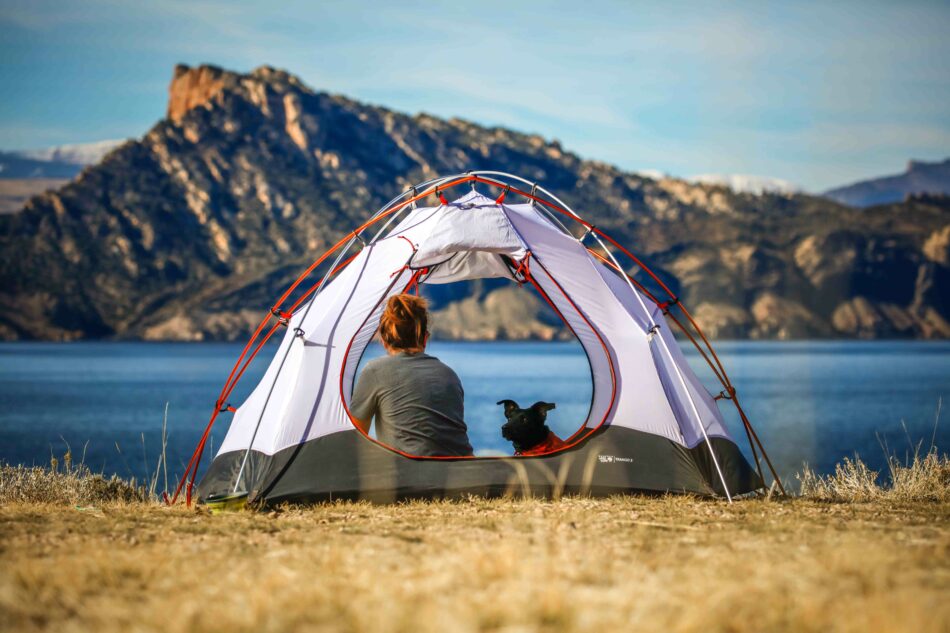
6. Staying cool
If you’re planning your canine-friendly camping trip during the summer months, temperatures can get hot – and uncomfortable. Dogs can easily overheat so making sure you provide your pup a shaded area and plenty of fresh water is essential to keep them cool while camping.
Whether your dog is camping out with you in a tent or underneath the stars, when the mercury rises, seek out spots that are well-shaded or covered so you both can stay cool. Big trees and covered camping structures are great options. And since hydration is key to a happy and healthy camping trip, make sure you refill your dog’s water bowl often with fresh, cool water.
7. Cosy canine space
One of the best parts of camping is cosying up in a sleeping bag after a long day enjoying the great outdoors. So how can you let your dog experience the same joy and wonder of that experience? By creating a spot all their own with a cosy and comfortable dog crate.
With the Fido Folding dog crate designed by Omlet, you can set up your dog’s personal space with ease so they can relax and feel safe throughout the trip. Easy to set up and take down, this dog crate is the perfect option for camping canines. Add a dog blanket from home to snuggle up with and your dog will be a happy camper in no time.
8. Keep them entertained
Your camping trip will likely include lots of walking and hiking with your four-legged companion, but how do you make sure your dog stays active and stimulated for the whole trip? To prevent boredom or restlessness in your dog while camping, be sure to pack some dog toys to keep them mentally engaged and busy. Stuff their favourite Kong with delicious dog-friendly treats and your pup will stay occupied during your entire fireside marshmallow roasting session.
9. Respect other campers
Remember, not everyone is a dog lover. If camping in a well-attended campsite, it’s possible you may encounter fellow campers who have animal allergies or who are just not ‘dog people’ like you. So be mindful and respectful of others by keeping your dog’s barking under control, avoiding their campsites, and cleaning up after your pup promptly. Fostering a positive camping environment makes the trip enjoyable for everyone.
10. Leave no trace behind
Last but not least, practice good outdoor ethics by following the “leave no trace behind” principles. This means not only picking up your own trash and debris, but cleaning up your dog’s waste, too. Pack plenty of poop bags to carry with you on walks and throughout the campsite to dispose of your dog’s ‘business’ in designated trash cans. Keeping the environment clean ensures a beautiful experience for future canine campers.
Canine camping with Omlet
Camping with your four-legged friend is a wonderful way to create lifelong memories and deepen your bond together. At Omlet, we believe there is no better way to connect with your dog than time spent together. That’s why we craft ingenious designs like our dog crates, cushion dog beds, and dog blankets so you can spend less time fussing over the essentials and more time enjoying your best friend.
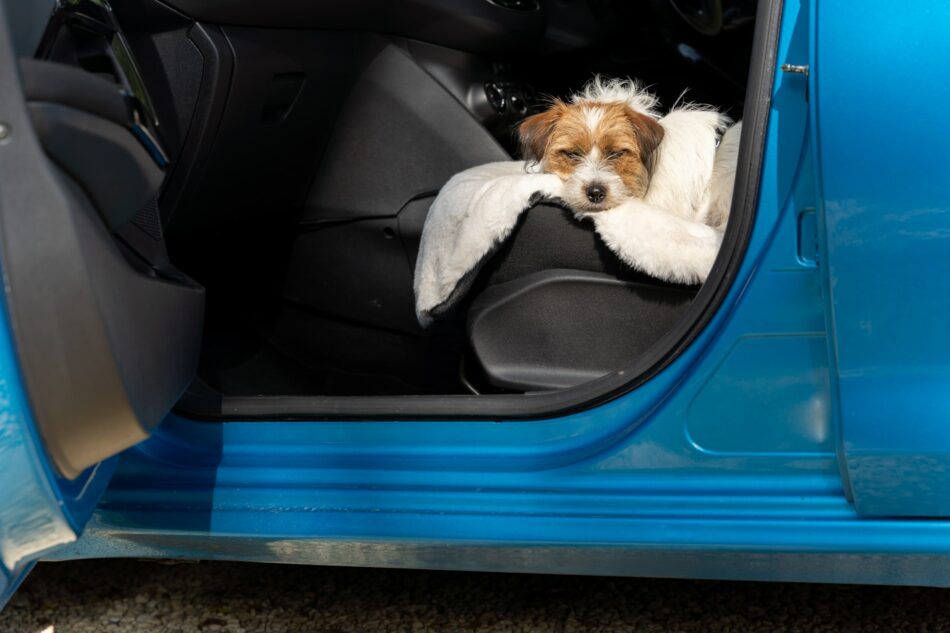

This entry was posted in Dogs on October 28th, 2019 by linnearask
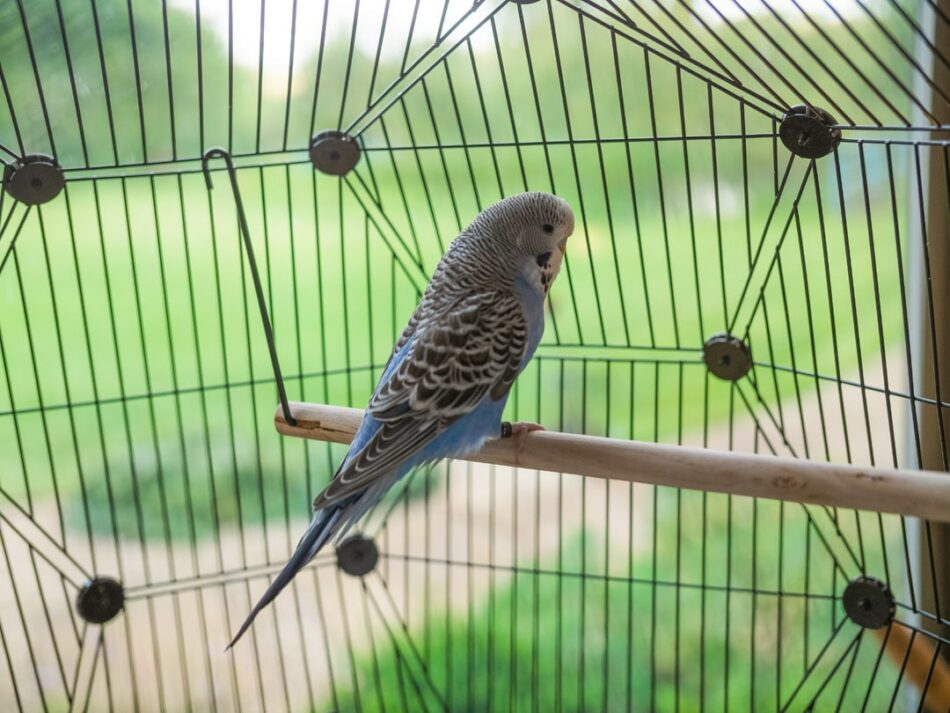
When you know how to care for a budgie, they make wonderful pets. Not only will their beautiful plumage brighten up any room, but they’re also very intelligent and sociable — developing strong bonds with their owners. Like with all pets, however, they come with responsibilities, and it is now your job to make sure they stay healthy and happy.
Diet and basic needs
Your budgies should consume the nutritional equivalent of what they would eat in the wild. The basis of their diet should be a good quality seed mix, and they should always have access to water and a cuttlefish bone. Offer leafy greens and herbs to provide vitamins and minerals a few times a week. Feed fruit as a treat no more than once a week, as these foods are high in sugar. Food and water containers must be refilled every day, and washed weekly.
Twice a year your budgies will moult, which means their plumage will gradually fall out and grow back. To help them stay healthy during this time, it’s important that they get extra moulting vitamins in their water.
Like most pets, budgies appreciate routine. Try feeding and letting them out of their bird cage around the same time every day. If you choose to use a bird cage cover at night time, it’s best to do this every day. This way the budgies will be able to anticipate the activity around them and feel comfortable in your presence – effectively minimizing stress and anxiety.
Enrichment and entertainment
Budgies are very social pets, and it’s always best to keep them as a pair – preferably siblings of the same sex who are used to living together. If you just want one budgie, you will need to act as its friend and companion, and can expect to spend a lot of time with them.
Most budgies like to bathe in a bird bath. The main purpose of a bird bath is to clear dust and sand from their feathers and to cool off. Even if your budgies don’t have these daily requirements, most budgies enjoy splashing around in the water. If you don’t have a bird bath in their cage, you can put a bowl of water in the room where the budgies are given flight permissions. It’s important to change the water as soon as it gets dirty in any bird bath.
If your pet doesn’t seem interested in a bath, an alternative is a budgie shower. Hang some wet leaves (lettuce, basil and parsley are favourites) in the cage, and watch your budgie run through them.
Budgies should be offered the opportunity to fly freely (but supervised) outside of their cage every day for at least 45 minutes. Ideally, budgies should be able to have multiple hours outside of their cage. Make sure the room is budgie-proofed before you let your pets out. Close windows and doors, block off fireplaces, turn off fans and air conditioners and keep other pets out of the room.
Check your cage
Check your budgies’ cage weekly to see that everything is in place and nothing has broken. Perches must be kept clean and functional. Bird toys are great for mental stimulation, as they encourage physical exercise and help wear their ever-growing beaks down. Change up your budgies’ toys every now and then to keep them interested. You don’t have to buy new toys all the time, but rotating through your budgies’ toys with the occasional new toy will help add variety to their environment. Your budgie’s environment is a crucial element in keeping them healthy and happy.
Health checks
Budgies’ beaks and nails grow constantly throughout their lives, so it’s important that they have access to toys to grind them down. In most cases you will need to trim the nails when they get too long, so make sure to purchase a pair of clippers made specifically for this task.
Budgies are very good at hiding pain and illness, and you’ll need to give them regular health checks. When you get to know your budgie, it’ll be easier to recognize when they aren’t feeling their best.
Signs of illness in budgies include:
- Changes in weight
- Discoloured feathers
- Reduced interaction with humans and toys
- Crusty nostrils
- Loss of feathers around the eyes or face
Another way of spotting early signs of illness is to regularly check your budgie’s droppings. The disposable paper liners in the Geo bird cage make it easy to monitor your pet’s health. When you do your weekly clean, check the amount, colour, and texture of the droppings. They can vary somewhat depending on what your budgie has been eating, but all faeces should be firm, with the urea (liquid portion) transparent and clear. If you notice changes or have other reasons to suspect that your budgie might be ill or in pain, contact your veterinarian. Make sure to find a vet that is experienced with birds – ideally before you bring your budgie home so you know who to contact if something goes wrong.
Omlet and your budgies
We’ve thoughtfully created the best bird cage for your budgies. The Geo Bird Cage has everything you need to make caring for your budgie easy, and to give them the perfect home. Customize their cage with bird mirrors and budgie perches to give them exciting ways to entertain themselves inside of their home. And with an optional bird cage stand and customisable cage colour options, your birds and their cage will both be a beautiful addition to any room.
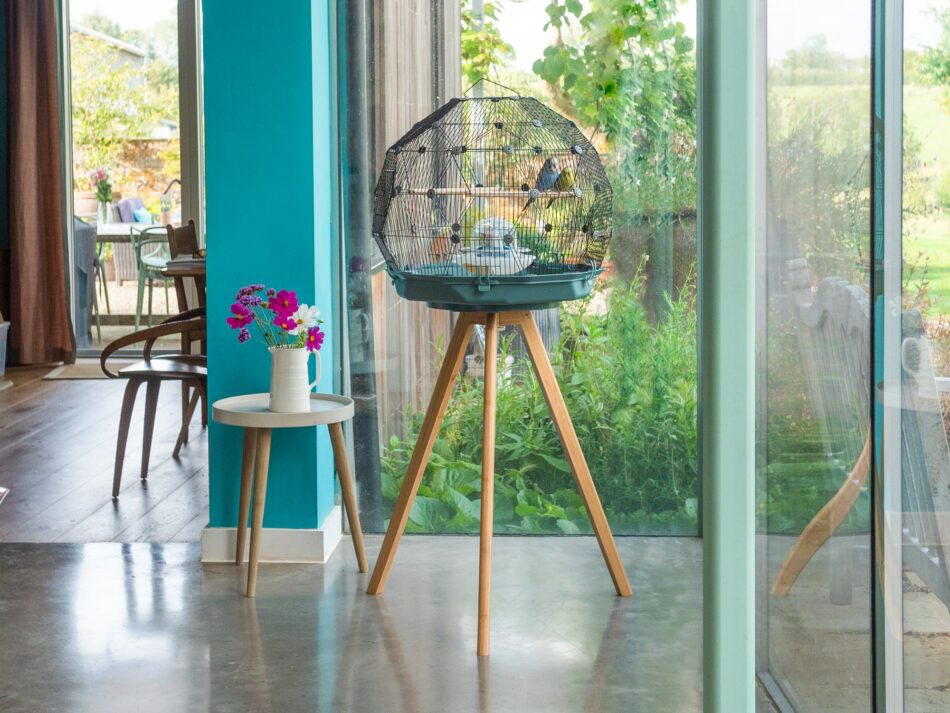
This entry was posted in Budgies on October 28th, 2019 by linnearask

Some pets hardly seem to notice fireworks. Others hide quietly until it’s all over. But some are genuinely traumatised by the noisy, flashing skies of Bonfire Night.
Forty years ago, fireworks in the UK were pretty much restricted to November 5th, with a few more on New Year’s Eve. But since then the original Bonfire Night – commemorating the foiled attempt of Guy Fawkes to blow up the Houses of Parliament – has partly uprooted and sprawled across the surrounding weeks to create a longer Fireworks Season. This begins around Hallowe’en on October 31st, and continues through to the weekend after November 5th, petering out slowly as people’s fireworks supply is used up.
For a pet who’s afraid of the bangs, whizzes and flashes, this extended fireworks season is bad news. There are, however, a few things you can do to minimise the stress.
The Big Bang
When talking about pets hating fireworks, we’re usually talking about dogs. The RSPCA estimates that 45% of dogs are afraid of fireworks to some degree.
Cats will find a quiet space away from all the fuss (although some individuals certainly get stressed by all the noise). Keep your cats indoors when the bonfires are blazing. They can quickly panic if fireworks go off suddenly nearby, or if sparkler-waving children come running down the street.
Small animals such as gerbils, hamsters and guinea pigs will either ignore the explosions or sit it out in their hidey holes.
Most caged birds don’t enjoy the sudden rupturing of the night skies – they like their nights to be dark and their days to be light, not a crazy mixture of the two. If your budgie, parrot, canary or pet finch is in a room affected by the flashing lights, you might want to cover the cage. But some birds don’t seem to ruffle a feather, in spite of the fireworks.
What you should never do is allow the pets to be trapped in their outdoor runs or aviaries with no bolt hole. As long as outdoor pets have a covered area to escape to, they should be fine.
Dogs Hate Fireworks
If your dog isn’t too fazed by the noise and lights, simply keep him indoors while the party rages outside. For more skittish dogs, there are a few extra precautions to take.
- Stay indoors with the curtains and windows closed. A scared dog caught outside is very likely to run away.
- Use a crate or other safe space. If there’s somewhere the dog associates with safety – a Fido Crate, perhaps, or a quiet room with a dog bed – make use of it. If there’s a room facing away from the main area of firework activity, put the dog in there. A bathroom often works well for this purpose. Gentle music can help keep out the noise too. Put familiar objects in the safe room – the dog’s bed and blanket, and some favourite toys. And stay with him, unless he’s happy to curl up and sleep through the storm.
- For very nervous dogs, vets recommend a wrap or dog vest, tight enough to apply gentle, constant pressure. This soothes and calms your poor pet.
- Stay calm yourself, and stay with your dog. That will help enormously.
- Don’t be tempted to let your dog go outside for any reason, and make sure he’s had his walk during the daylight. Even a dog who takes it all in his stride indoors might suddenly panic outdoors when the fireworks start to fizz.
Prepare In Advance
You can desensitise dogs to the sound of fireworks to a certain extent, by getting them used to loud noises. The best way to do this is to play thunderstorm or fireworks sounds at a low volume, giving the dog treats and lots of fuss and play in the meantime. If you then increase the volume while keeping up the treats and play, it will, in most cases, make your dog associate the noise with good times.
This doesn’t work with all dogs, but it’s definitely worth a try if you want to have a stress-free Fireworks Night. There’s not long to go, so better start now!
This entry was posted in Pets on October 24th, 2019 by linnearask
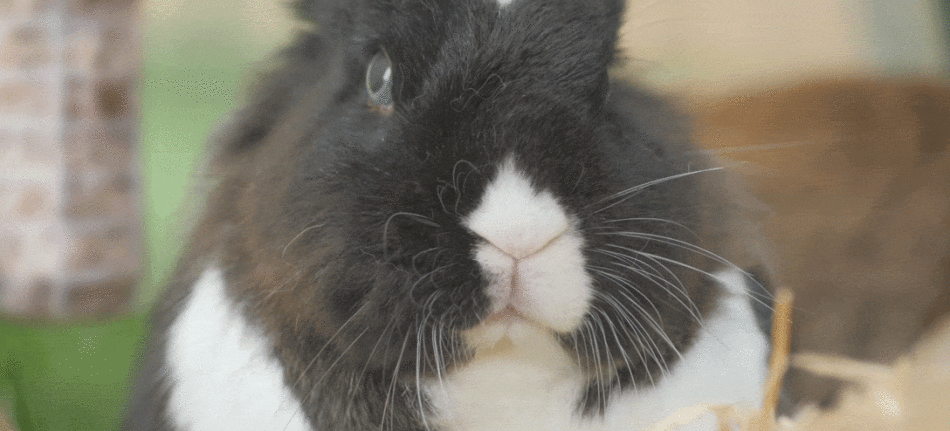
Rabbits will most likely not show any signs of illness or pain before it is really serious, as any weakness would mark them as an easy target for predators in the wild. It is therefore important that you, as an owner, carry out regular health checks on your pet, so that you are able to spot potential problems while they are still treatable.
Always take your rabbit to the vet as soon as you suspect something is not right. A rabbit’s health can deteriorate very quickly, so don’t lose any time wondering if it’s worth it or not.
Body
Put a towel on your lap and place your rabbit on top of it. Stroke him or her to calm them down. When your rabbit has settled, you can start examining their body.
Feel the stomach to make sure it’s not swollen or distended, and go through the rest of the body for signs of cuts, bruises or lumps. Feel the muscles in the legs, they should be strong and firm. Any wincing or unexpected movement from the rabbit could be a sign that the body part you’re touching is causing your rabbit pain.
Check your rabbit’s breathing; it should not be laboured. Wheezing or clicking noises from the lungs can be signs of illness.
It is worth getting a set of scales and regularly weighing your rabbit. Sudden weight loss is a serious sign of illness, and a lack of appetite is a strong indicator of poor health.
Mouth and nose
The nose should be dry and not have any discharge. Check that the rabbit is not dribbling, and that it doesn’t have any sores or cuts around the mouth. The gums should be pink (a red or purple colour is a sign of illness).
Make sure the teeth are not overgrown or damaged. They should also be growing straight, and be uniform. You won’t be able to see the back teeth, but if you move your fingers over the cheek you can feel for lumps, and make sure that everything is symmetrical. Overgrown teeth are a serious problem as this can prevent your rabbit from eating, which is why it is very important to give them plenty of good quality hay to wear the teeth down with.
Eyes
Check your rabbits eyes to make sure they are clean and clear. You shouldn’t see any discharge or dirt. If you do, carefully pull back the eyelid to see if you notice any redness or pus in the eye; it is possible that the rabbit has scratched its eye. The eyes should also be dry; runny eyes can be a sign of teeth problems, or possibly ingrowing eyelashes or blocked tear ducts.
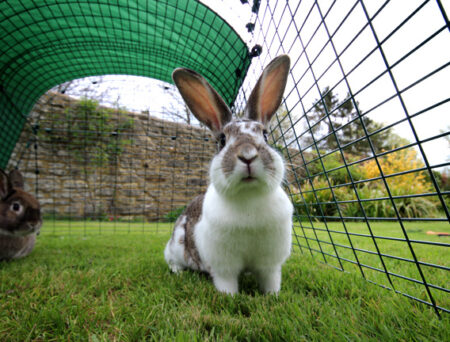 Ears
Ears
Rabbit ears should be free from any dirt, wounds, lumps, wax, discharge or parasites. Look inside the ears; you can use a torch if it’s difficult to see. Take extra care if you have a lop rabbit as they are particularly prone to abscesses around the ears. Carefully massage the base of the ears, where lumps can sometimes occur.
Feet
Watch your rabbit move around to make sure it’s not limping and doesn’t have any lameness in the legs. Pick up your rabbit and put him or her on your lap. It’s not a good idea to put a rabbit on its back, so hold it against you with one hand under its bottom. Try spreading the toes to check for scabs, abscesses or a build up of dirt. Also check the heels on the back feet. These should not be red or swollen. Check the fur on the feet and brush it if it’s matted.
Rear End
Check the fur around the bottom. It should be completely clear from faeces or other dirt. A dirty bottom can be a sign that the rabbit’s diet is too rich and that they are not eating all the caecotrophs they produce.
During summer you should check for any build up of dirt at least once a day, as a dirty bum can attract flies that lay eggs in the damp fur. This causes a condition known as flystrike, which can kill a healthy rabbit in a matter of days.
Also check the rear end for any swelling or redness.
Coat
With your rabbit sat on your lap, part the hair with your fingers and check for cuts and wounds, bald patches, anything moving, small brown dots or white flakes.
Even if you don’t have a rabbit that requires grooming on a daily or weekly basis it is good to get your pet used to brushing from an early age. Rabbits moult regularly, and you might need to help them get rid of dead hair from their coat during this time.
Changes in temperament
Sudden changes in temperament and behaviour is never a good sign. Maybe your rabbit doesn’t come running when you approach it with food in the morning, or is suddenly aggressive. These might be signs your rabbit is in pain.
Rabbits who reach sexual maturity can sometimes act very differently. Spraying is a common problem, as is aggression. Your rabbit might not be in pain, but it can be very distressing for them to go through this ‘puberty phase’. This might be a good reason to get your pets neutered as soon as they are old enough.
This entry was posted in Rabbits on October 21st, 2019 by linnearask

Hamsters love to play and explore! There are many toys and treats available to buy for your furry friend, but wouldn’t it be great to design and construct an exciting maze for them? They are easy and fun to make and will provide hours of fun!
Here’s what you’ll need:
- A shallow box, something like a vegetable box from a supermarket or an old suitcase.
- Thin cardboard to make the walls, tunnels and other parts of the maze.
- Non toxic glue – we used a glue gun.
Now for the fun part!
Create walls, tunnels, bridges, caves and more, securing them to your box using non toxic glue. The more things in the maze, the better!
We added a little teepee as a finish point, and placed a treat inside for our hamster to find.
Not all routes need to lead to the teepee. Some paths could lead to a dead end, or you could give your hamster an option of two different tunnels to go through, leading to two different parts of the maze. The green tunnel or the yellow tunnel…which will your hamster choose?
Your hamsters will more than likely try to climb out of their maze from time to time so make sure you keep a close eye on them while they are having fun exploring!
Grab some card, glue and a box and get creative!
We’d love to see photos of the mazes that you produce, please send them to marketing@omlet.co.uk and we will share our favourites!
This entry was posted in Hamsters on October 16th, 2019 by linnearask

Have you ever found your dog or cat curled up in some tiny, enclosed places around the house when the weather gets cold? Perhaps under the bed, behind the sofa, or even in an empty box? This is because when the temperature drops, most of their usual snoozing spots become very cold and are exposed to chilly drafts. You can help your pet find a more comfortable and warm space for naps in winter by creating a snuggly den that they can call their own. Read on to find out how…
Find a cosy corner of your home
Keep an eye on your pet’s favourite places to curl up for naps, they will probably be showing you their preferred spot for feeling secure so they can completely relax without keeping one eye open. This should be in a warm room in your house where they will have some company, but not so much that they will be kept awake or interrupted frequently. If you have young children in the house, you might want to consider a room that the little ones have little access to.
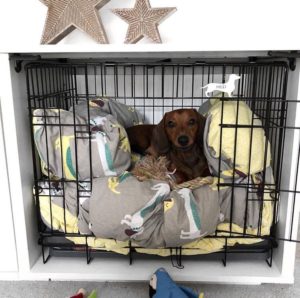
Find the perfect bed
Sleeping on your bed or sofa might be your dog or cat’s usual spot for comfort and cosiness, but unless they sneak under the covers, they will likely still be exposed to those pesky drafts, nevermind the fact your bed will be victim to muddy paw prints! Placing their bed within something else to create a ‘den’ is an ideal solution.
The Fido Nook Dog House and Maya Nook Cat House offer just that. Designed like a piece of furniture, the Nook offers a much more secure space where your pet’s bed can be slightly raised off the ground and concealed further by the roof to limit drafts and maximise comfort. The Nook is also available with curtains which can be attached to the front and back for further warmth and cosiness. For more anxious pet’s who may get worried by loud noises and fireworks, the curtains provide extra security and the feeling of being hidden, without your pet needing to get stuck behind the sofa!
To complete your pet’s new den, you need to carefully pick the perfect cosy bed for them. You probably already have some idea of what your pet does and doesn’t like to sleep on. The Classic Fido bed offers a simple, mattress-like bed for your pet to relax into without feeling enclosed or overheating.
Add the finishing touches
A cosy den isn’t complete without blankets and cushions. Finally, pop your pet’s favourite cuddly toy inside to make the new den really feel like home!
This entry was posted in Cats on October 12th, 2019 by chloewelch

Finally there is a budgie cage as good looking as the budgies
The revolutionary NEW Geo Bird Cage from Omlet is a breathtaking, contemporary design that redefines what a pet bird’s habitat can and should be. The geodesic shape defines a light and spacious habitat for your birds, creating the perfect environment to reveal their natural beauty.
Rigorous design and testing have refined the Geo Bird Cage into a final form that has nothing superfluous but leaves nothing out.
Simon Nicholls, Omlet’s Head of Design said “The inspiration for the Geo Bird Cage came from a really amazing polymath called Buckminster Fuller, who pioneered geodesic domes in the 50’s. Once we had the form we developed over 60 prototypes to ensure that every aspect was optimised for both the bird and the owner. I couldn’t be prouder of the finished product.”
A good example of the care and attention to detail throughout the Geo is the central feeder. A delight for both owner and budgie to use, it’s also a remarkable piece of engineering. It intelligently catches any dropped husks and seeds in a hopper making this the cleanest bird cage of its kind.
Pet birds are the 4th most popular pet in UK households according to the annual PFMA report. Budgies have long been a favourite with children, parents and grandparents as they enjoy human company and can be easily trained to land on your hand and can even learn to speak. With Omlet’s latest innovation, keeping budgies is easier, cleaner and better looking than ever before!
Available in a choice of teal and cream base colours, the Geo Bird Cage can be further customised with a choice of two stand heights. Made from solid bamboo, the stand elevates your Geo Bird Cage to either coffee table level or higher. No other small bird cage creates such a captivating centrepiece for your home.
The Constellation Geo Bird Cage Cover is typical of the kind of thoughtful touches pet owners have come to expect from Omlet. Decorated on the inside with a map of the stars, when it’s placed over the Geo at night, budgies can try to spot Orion, Ursa Major and maybe even a shooting star before they nod off to sleep!
The Geo Bird Cage is available exclusively at Omlet, from £99!
This entry was posted in Budgies on October 9th, 2019 by chloewelch
The Omlet Christmas Shop is back and better than ever!

Tick off Christmas presents for your VIPs (very important pets) with the Omlet Christmas Shop and our wide range of festive toys, treats and more, for all of your beloved pets.
Kick off the most wonderful time of year with our range of advent calendars for dogs, cats, and small animals. A fun, festive tradition which kids (and grown ups) will love sharing with their furry friends.
For dogs, we have a wide range of delicious treats in a variety of Christmas flavours, from Turkey bites to Christmas pudding cookies, as well as fun and cuddly toys that will keep them happy in the excitement of Christmas Day! You can even keep your canine friend cosy and warm this December, with our super cute winter jumpers available in 3 sizes.
For the feline residents of your home a wide selection of treats and toys are available, including a Grumpy Cat LED lights wand and brussel sprouts rattles for interactive play. The Deluxe Christmas Stocking makes the perfect gift for your fellow crazy cat lovers, and are also available for all other animals.
Back by popular demand this year is our delightful Christmas Coop-pourri. Add a fresh scent of Christmas cheer to your girls’ nesting area with our blend of fifteen herbs, flowers and spices, including notes of cinnamon and clover. For chickens, we also have our popular Peck Toys, Caddi Treat Holders, plus new hanging seed decorations. The new Automatic Chicken Coop Door makes a great gift for chicken keepers as it can be fitted to all wooden coops, the Eglu Cubes and all Eglu runs.
For small pets, including rabbits, guinea pigs and hamsters, we have a variety of Christmas themed gnaws, as well as a super cute snowy igloo and a delicious celebration cake!

This entry was posted in Christmas on October 8th, 2019 by chloewelch
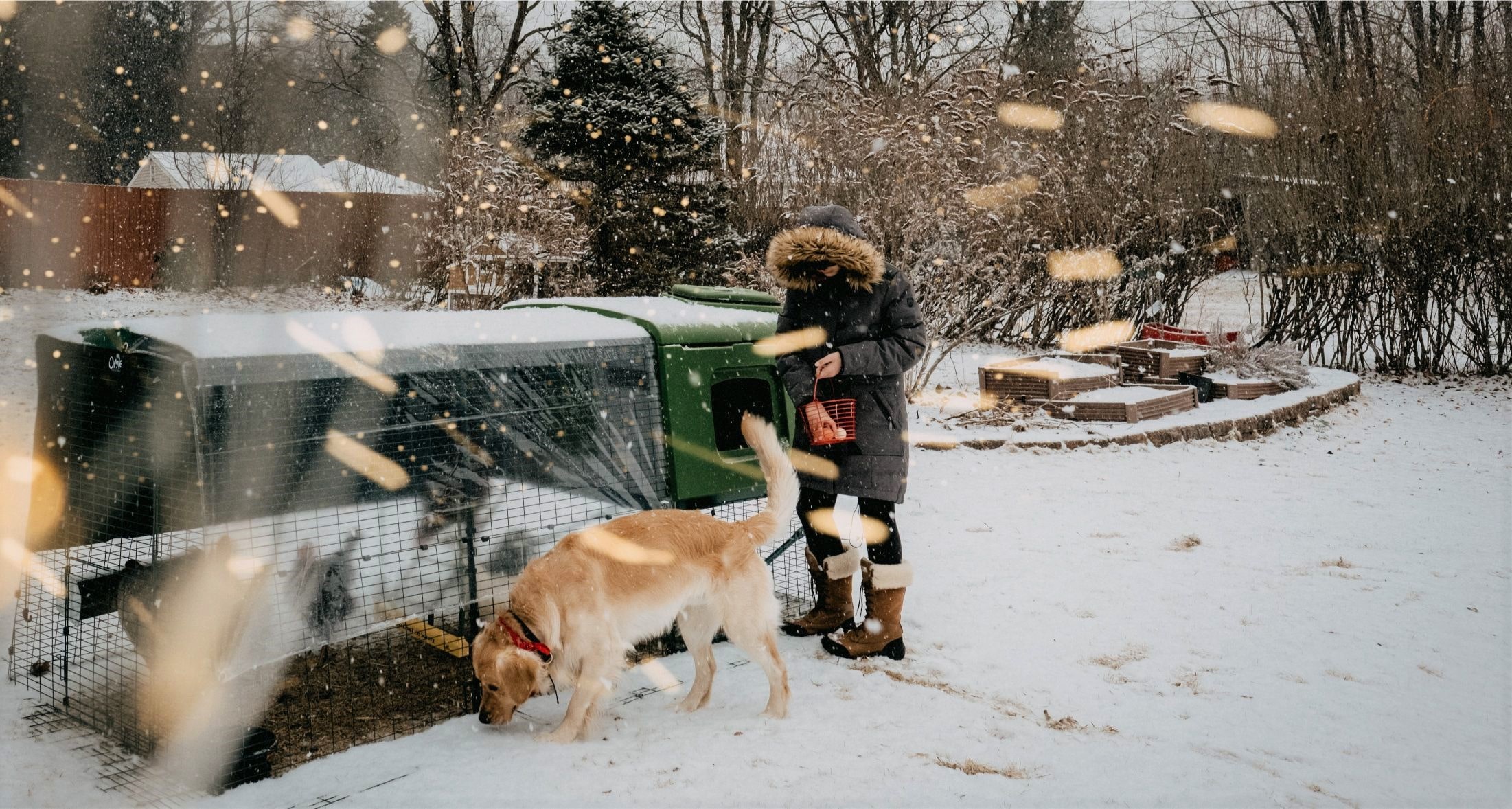
Cold weather can be a worry for chicken keepers but there are ways to prepare your chicken coop for winter. Preparations such as:
- Moving you coop closer to your house
- Upgrading to a plastic coop
- Installing an automatic chicken coop door
- Adding a chicken run cover
- Adding an extreme temperature jacket
Get your chickens’ coop ready for the colder months and you will be able to and rest easy knowing that your girls are warm and healthy throughout winter. Take a look at some of our top tips for getting your chicken coop winter-ready.
Move Your Coop Closer to the House
Moving your chicken coop closer to the house is a simple step for making it easier for you to look after your girls and give them their daily health checks, which are even more important in the colder months. Choose a lightweight coop with wheels, like the Eglu, to make it even easier to move it around your garden.
Upgrade Your Wooden Coop to a plastic chicken coop

Upgrading your wooden chicken coop to a plastic coop has many benefits. The main benefit of a plastic Eglu Cube Chicken Coop for chicken keepers in winter is the twin wall insulation found in the design of the plastic house. This works in a similar way to double glazing, by creating a barrier between the cold air outside the coop, and the air in side. The air between the two walls conducts poorly, which means inside the house stays at a consistent and warm temperature throughout winter, whatever the weather is doing outside. Chickens are very efficient at keeping themselves warm, all you will need to do is make sure the coop door is shut at night time.
Install an automatic chicken coop door
Installing an Automatic Chicken Coop Door is a convenient solution for plastic or wooden chicken coops allowing you to shut your chicken coop’s door at dusk even if you are not yet home.
You can set the Autodoor to close at a specific time or light percentage to suit when all your girls have gone up to bed and the sun has set. The Autodoor runs off batteries and has been tested to work down to -10 degrees celcius so there is no worry, however cold it gets outside!
The other benefit to the Autodoor is that it will open again at dawn so you can head off to work early before the sun rises and your girls need to be let out, or you can stay in bed for even longer at the weekends without going out in the freezing cold to let your chickens out of their coop!
The NEW Coop Light also makes it easier for you to check on your girls and carry out daily chicken keeping duties if you don’t get home until after dark. This plugs directly into your Autodoor control panel, and can even be programmed to automatically turn on 5 minutes before your Autodoor closes to encourage your chickens up to the coop.
“The nights are drawing in and I couldn’t be happier knowing that my girls are safely tucked up in bed with their Omlet Autodoor closed behind them. The Autodoor has given me peace of mind, flexibility and a well needed lie in! Couldn’t recommend it enough!” – Hayley’s Lottie Haven
Add a chicken run cover
Chickens are very good at coping in cold temperatures, but don’t like getting wet, adding a run cover allows them to be protected from the elements when outside in their run. Covers are available in a variety of sizes to suit your run length, the clear run covers protect your girls from wind and rain so they can continue to play whatever the weather, whilst still allowing light into the run.
Add an extreme temperature jacket
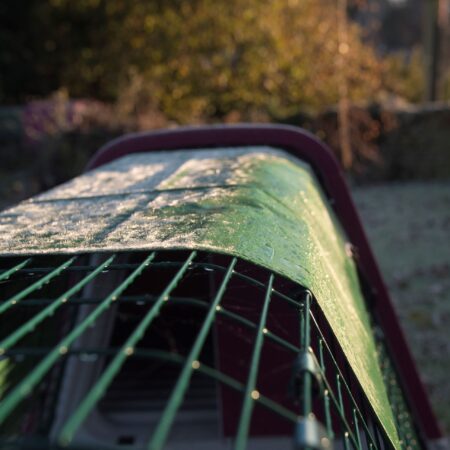
When the temperature drops below freezing for multiple days in a row during the very depths of winter, it might be wise to give your chickens extra warmth with an extreme temperature jacket. Filled with a heat trapping recycled material that is breathable, the jackets keep your pets warm and protected from the worst that the weather can throw at them. Preparing your chicken coop for the winter will definitely benefit poorly or older chickens.
Provide Hentertainment
Prevent chickens getting bored when rain stops play with a variety of fun and interactive toys that can keep them entertained in all weathers. The Chicken Perch provides an easy outdoor perch which can be installed in their run (and protected by the run covers) for when your chickens can’t perch in their usual spots around your garden. The Chicken Swing provides hours of fun and again, can be easily installed in any run. While the Peck Toys and Caddi Treat Holder offer enriching entertainment as well as a rewarding flow of treats.
Water Heaters & Chicken Treats
Prevent your chickens’ water from freezing with a water heater to ensure they have access to flowing water at all times. It is also recommended to provide extra layers pellets and treats during winter, as chickens will need more energy to keep themselves warm and lay their eggs in the colder months.
This entry was posted in Chickens on October 8th, 2019 by chloewelch

Budgies make great pets. They’re easy to look after, intelligent, easily trained, and small enough not to eat you out of house and home or demand lots of space.
Because of the easy availability of budgies, it’s tempting to simply nip to the nearest pet store, bring one home, and take it from there. However, it’s worth answering a few questions first, to make sure you’re making the right choice, buying from the best place, and bringing the budgie home at the ideal time.
Where From?
The best place to source a budgie is from a local breeder. They will know the bird’s pedigree (and may even be able to introduce you to your new pet’s parents!) They will also know the exact age of your budgie, and will be able to give you details of the variety of bird you are getting. This won’t make any difference to looking after it, but will help you understand exactly why your pet has a particular colour or pattern – e.g. Opaline, Spangle, Skyblue, Texas, Yellow Face, Frilled, or a dozen other varieties.
Check online of in a local directory for a list of local budgie breeders. The closer to home the better, as it’s best to minimise car journeys when bringing new birds home.
A good pet shop is the second best option. The budgies here will usually be healthy, but the shop will not have bred the birds itself, and so will not usually have full background knowledge of each individual. They may also be a little vague about the age of the pets they have on sale. Shop birds are often relatively old, and a bit set in their ways. This makes them more difficult to hand-tame.
Where To?
Budgies needs a suitable space in the home, away from direct sunlight, draughts, steamy kitchens, scary dogs and cats, screaming children and bright lights. They also need a cage of a suitable size, equipped with all budgie mod cons. The geodesic Geo bird cage makes a perfect home for all small birds, including budgies.
When to Buy?
A budgie should not be brought home before it has passed the eight-week mark, and ideally it should be no older than 16 weeks. Young birds are much easier to hand-tame and train, and young males have a better chance of becoming talking budgies.
Older birds, especially ones that have lived in a cage with other budgies for a long time, tend to be less trusting of humans and therefore more difficult to train. However, an older budgie that has already had experience of perching on human hands will make the transition easily, regardless of its age.
You can check the age of the bird yourself, using a simple visual clue. Young budgies have horizontal stripes across their heads, including the forehead. These disappear after the bird’s first moult, (three to four months after hatching). So, any bird with a barring pattern on the head will be less than 16 weeks old.
As for your own part in the ‘when?’ question, bring your new budgie home at a time of relative peace and quiet. Renovations, house moves and long holidays are not good times to buy a new pet!
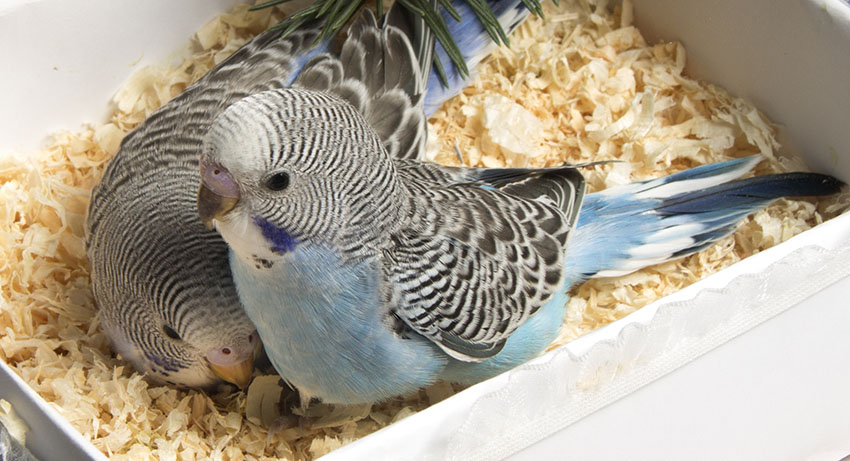
Which Type?
All budgies are beautiful, whatever their age, gender, colour or coat pattern. It’s best not be dazzled by colour. Sometimes you’ll see a budgie with unusual or colourful plumage and think ‘That’s the one!’ But there are more important factors to consider, such as age, personality, and gender.
Ideally, you want a young, confident bird. An older budgie will take more time hand-taming; a shy one is likely to remain shy and flighty; and a female bird is not going to talk (if that’s something that’s important for you as a budgie keeper – although bear in mind that no budgie is guaranteed to learn how to talk).
Why?
This is a deceptively simple question. Why do you want a budgie? Is it for you, for the children, as a companion for an existing bird, or a replacement for a budgie that has passed away?
All pets require our time, and budgies are no exception. They should never be purchased simply to make a house look prettier, but should be considered as friends and companions.
Children don’t make good budgie keepers – at least, not if they are under the age of 10. Birds are very fragile, and easy to injure or frighten. They also require regular and reliable care, in terms of feeding and cleaning.
It may sound like a good idea to buy your lonely budgie a new friend, but the birds won’t always automatically hit it off. The newcomer will often end up bullied and unhappy, and you may need to separate them. This is less of an issue if you have a larger aviary, with plenty of space for a new bird to find his feet, to hide if necessary, and to gradually work out his place in the hierarchy.
Why Not?
It’s not all pros – there are cons too, as with any pet. Budgies, although not in the same league as cockatiels and larger members of the parrot family, are still noisier than the average finch or canary. They mix their musical bubbling chatter with squawks that can become very grating.
If the squawking goes on and on, it usually means the bird is unhappy with something in its cage or in the immediate environment. Make sure there are no drafts, ensure that the bird is not trapped in sunlight without shade, make sure the food tray and water dispenser are topped up, and keep other pets out of the room.
Then there’s the mess. Budgies manage to scatter seed husks over the floor, and at moulting time the slightest breeze will send handfuls of downy feathers floating to the ground. They’re not super messy, but obsessively tidy owners may start to get twitchy! By purchasing a cleverly designed cage, like the Geo, you will minimise the spill from the budgie flapping wings.
If you’ve considered these basic questions and decided to go ahead and buy a budgie, the rest is plain sailing and many years of happy companionship with your feathered friend.

This entry was posted in Budgies on October 8th, 2019 by linnearask
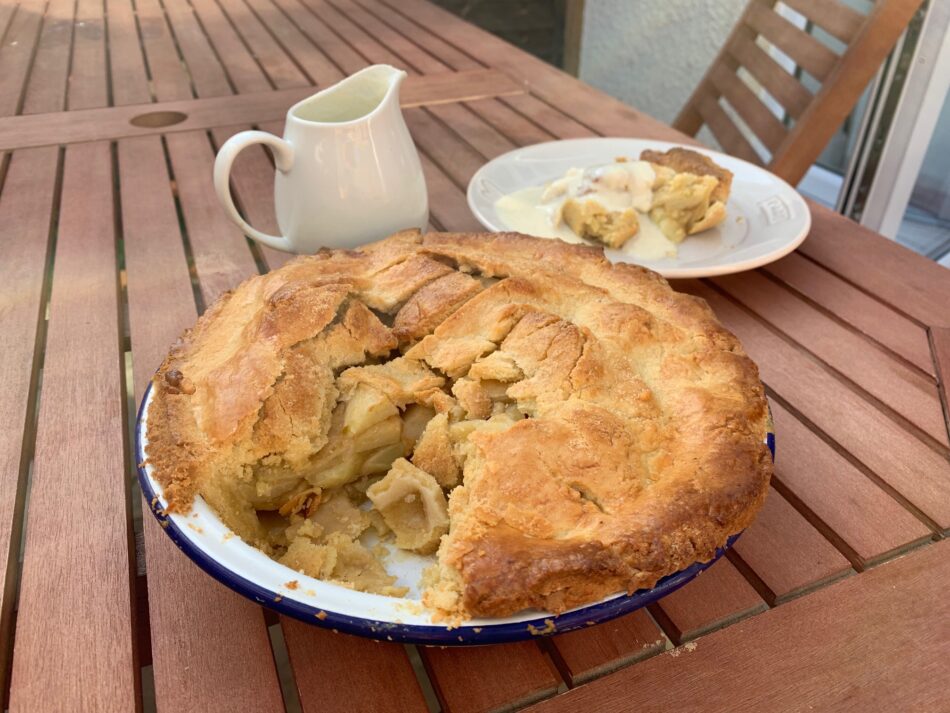
As the leaves begin to fall and the evenings get shorter we all start to crave comfort food. What’s more comforting and warming than hot apple pie with homemade custard?! Apples are in abundance this time of year so grab some cooking apples and cosy up with a bowlful of this homemade yumminess.
Ingredients:
Filling
4 Cooking Apples
150g Golden Caster Sugar
Pinch of Cinnamon
3 tbsp Plain Flour
Pastry
250g Unsalted Butter
50g Golden Caster Sugar
2 Eggs
350g Plain Flour
Custard
2 tsps Vanilla Bean Paste
1 pint Whole Milk
4 large Egg Yolks
2 tbsp Caster Sugar
1 tbsp Cornflour
Method:
- The filling- Peel, core, quarter and slice 4 cooking apples. Lay them out on paper towels to get as much liquid out of them as possible. Leave until you need them later.
- Mix the sugar and flour for the filling with cinnamon and place in a bowl big enough for the apples and set aside.
- For the pastry- beat the butter and sugar together then whisk in 1 whole egg and 1 egg yolk (save the white for glazing pastry later.)
- Now fold in the flour slowly until it starts to form a ball, collect the remainder of the pastry together with your hands and form a solid ball. Wrap and place in the fridge to cool for 1 hour.
- Whilst the pastry is cooling, make a start on your custard.
- The custard- Heat the whole milk and vanilla bean paste to boiling then take it off the heat. Whilst that cools slightly, in a large bowl whisk 4 egg yolks, sugar and cornflour then slowly start to add the milk mixture in ladle by ladle whilst continually whisking.
- When all the milk is added to the mixture, pour it back into the saucepan and place on a low heat for roughly 20 mins, continuously stirring, take off heat when the custard becomes thick.
- Take pastry out of the fridge and set aside a third of the pastry for pie top. Roll the majority of the pastry out to fit your pastry dish, make sure there is a bit of overhang.
- Put the apples into the bowl with the sugar and flour and coat the apples using your hands. Now pile the apples into the pastry tin, then roll out the remaining ball of pastry.
- Brush some water around the edges of the pastry in the tin and then lay the other round of pastry on top and join them.
- Trim the left over hanging pastry off of the tin and make 5 slits in the top of the pastry to let the steam out.
- Preheat oven to 190 degrees c and place the pie in for 40mins until golden brown.
- Allow to cool for 5 mins then serve with hot or cold custard.

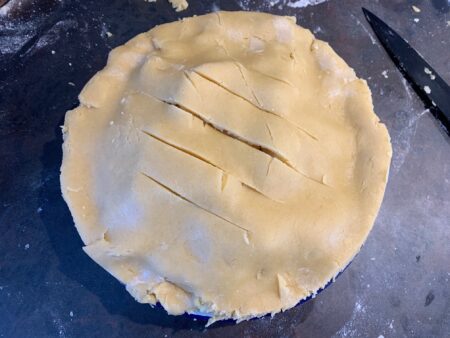
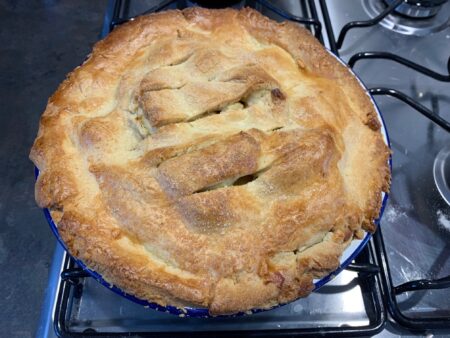
This entry was posted in Recipes on October 4th, 2019 by linnearask









 Ears
Ears

















